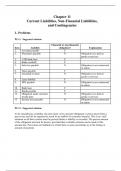Exam (elaborations)
Solutions for Intermediate Accounting, Volume 2, 5th Edition by Kin Lo
- Course
- Intermediate Accounting
- Institution
- Intermediate Accounting
Complete Solutions Manual for Intermediate Accounting, Volume 2, 5th Canadian Edition by Kin Lo, George Fisher. ISBN-13: 4919 Full Chapters Solutions are included for Vol 2 5ce Kin Lo Current Liabilities and Contingencies Non-current Financial Liabilities Equities Complex Financial Instrum...
[Show more]



